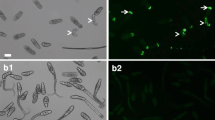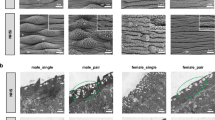Abstract
The cercariae of Schistosoma japonicum were subjected in vitro to treatments known for Schistosoma mansoni to generate schistosomula-like organisms. As a technical prerequisite to pipette or to otherwise handle the sticky cercariae of S. japonicum, the addition of protein to water or medium was found to abolish the stickiness of cercariae of this species. Shearing forces exerted in vitro by syringe (22 G) passage are known since long to fully transform S. mansoni cercariae, but this treatment was found to be much less efficient with S. japonicum. Thus, even with very narrow needles (27 G), complete transformation of cercariae was not obtained with S. japonicum. Complement, provided by fresh human serum, is also well known to induce rapid transformation of S. mansoni cercariae with subsequent killing of the schistosomula. This treatment of S. japonicum cercariae induced degeneration of the tails and strongly promoted the transformation to schistosomula-like organisms, but at a much slower pace. These effects were absent from sera either heat-inactivated or depleted of factor B or of complement component C8, but were restored after adding the purified respective complement components. The schistosomula-like organisms of S. japonicum were not susceptible to lysis after 1 day of in vitro culture in the presence of 50% fresh human serum, although both cercariae and schistosomula of S. mansoni were killed under these conditions. In conclusion, the dynamics of in vitro transformation of S. japonicum cercariae differ significantly from those of S. mansoni, and complement has a major transformation-promoting activity.


Similar content being viewed by others
References
Bash PF (1991) Schistosomes: development, reproduction, and host relations. Oxford Univ Press, New York
Chlichlia K, Schauwienold B, Kirsten C, Doenhoff MJ, Fishelson Z, Ruppel A (2005) Schistosoma japonicum reveals distinct reactivity with antisera directed to proteases mediating host infection and invasion by cercariae of S. mansoni or S. haematobium. Parasite Immunol 27:97–102
Clegg JA, Smithers SR, Terry RJ (1972) The effects of immune rhesus monkey serum on schistosomula of Schistosoma mansoni during cultivation in vitro. Int J Parasitol 2:79–98
Colley DG, Wikel SK (1974) Schistosoma mansoni: simplified method for the production of schistosomules. Exp Parasitol 35:44–51
Eveland LK, Morse SI (1975) Schistosoma mansoni: in vitro conversion of cercariae to schistosomula. Parasitology 71:327–335
Gazzinelli G, De Oliverira CC, Figueiredo EA, Pereira LH, Coelho PMZ, Pellegrino J (1973) Schistosoma mansoni: biochemical evidence for morphogenetic change from cercaria to schistosomule. Exp Parasitol 34:181–188
Gold D, Flescher E (2000) Influence of mechanical tail-detachment techniques of schistosome cercariae on the production, viability and infectivity of resultant schistosomula: a comparative study. Parasitol Res 86:570–572
Greenblatt HC, Eveland LK, Morse SI (1979) Schistosoma mansoni: Complement and cercarial tail loss during in vitro transformation. Exp Parasitol 48:100–108
Gui M, Kusel JR, Shi YE, Ruppel A (1995) Schistosoma japonicum and S. mansoni: comparison of larval migration patterns in mice. J Helminthol 69:19–25
He YX, Salafsky B, Ramaswamy K (2005) Comparison of skin invasion among three major species of Schistosoma. Trends Parasitol 21:201–203
James AER, Taylor MG (1976) Transfomation of cercariae to schistosomula: a quantitative comparison of transformation technique and of infectivity by different injection routes of the organisms produced. J Helminthol 50:223–233
Locker ES (1983) A comparative study of the life-histories of mammalian schistosomes. Parasitology 87:343–369
Ramalho-Pinto FJ, Gazzinelli G, Howells RE, Mota Santos TA, Figueiredo EA, Pellegrino J (1974) Schistosoma mansoni: defined system for stepwise transformation of cercariae to schistosomule in vitro. Exp Parasitol 36:360–372
Ruppel, A, Rother U, Diesfeld HJ (1982) Schistosoma mansoni: development of primary infections in mice genetically deficient or intact in the fifth component of complement. Parasitology 85:315–323
Ruppel A, McLaren DJ, Diesfeld HJ, Rother U (1984) Schistosoma mansoni: escape from complement mediated parasiticidal mechanisms following percutaneous primary infections. Eur J Immunol 14:702–708
Ruppel A, Shi YE, Moloney NA (1990) Schistosoma mansoni and S. japonicum: comparison of levels of ultraviolet irradiation for vaccination of mice with cercariae. Parasitology 101:23–26
Ruppel A, Chlichlia K, Bahgat M (2004) Invasion by schistosome cercariae: neglected aspects in Schistosoma japonicum. Trends Parasitol 20:397–400
Salafsky B, Fusco AC, Whitley K, Nowicki D, Ellenberger B (1988) Schistosoma mansoni: analysis of cercarial transformation methods. Exp Parasitol 67:116–127
Smithers SR, Terry RJ (1965) The infection of laboratory hosts with cercariae of Schistosoma mansoni and the recovery of adult worms. Parasitology 55:695–700
Stirewalt MA (1974) Schistosoma mansoni: cercaria to schistosomule. Adv Parasitol 12:115–182
Stirewalt MA, Cousin CE, Dorsey CH (1983) Schistosoma mansoni: stimulus and transformation of cercariae into schistosomules. Exp Parasitol 56:358–368
Wang L, Li YL, Fishelson Z, Kusel JR, Ruppel A (2005) Schistosoma japonicum migration through mouse skin compared histologically and immunologically with S. mansoni. Parasitol Res 95:218–223
Whitfield PJ, Bartlett A, Khammo N, Brain APR, Brown MB, Marriott C, Clothier R (2003) Delayed tail loss during the invasion of human skin by schistosome cercariae. Parasitology 126:135–140
Wilson A (1987) Cercariae to liver worms: development and migration in the mammalian host. In: Rollinson D, Simpson AJG (eds) The biology of schistosomes: from genes to latrines. Academic Press, London, pp 115–146
Yasuraoka K, Irie Y, Hata H (1978) Conversion of schistosome cercariae to schistosomula in serum-supplemented media and subsequent culture in vitro. Jpn J Exp Med 48:53–60
Acknowledgements
This work was supported by the Ministry of Science and Art Baden-Württemberg. We are grateful to Professor Yong-long Li (Dept. of Parasitology, Tongji Medical College, Huazhong University of Science and Technology, Wuhan, China) for providing infected Oncomelania hupensis.
Author information
Authors and Affiliations
Corresponding author
Rights and permissions
About this article
Cite this article
Wang, W., Kirschfink, M. & Ruppel, A. Schistosoma japonicum and S. mansoni cercariae: different effects of protein in medium, of mechanical stress, and of an intact complement system on in vitro transformation to schistosomula. Parasitol Res 99, 269–274 (2006). https://doi.org/10.1007/s00436-006-0150-y
Received:
Accepted:
Published:
Issue Date:
DOI: https://doi.org/10.1007/s00436-006-0150-y




